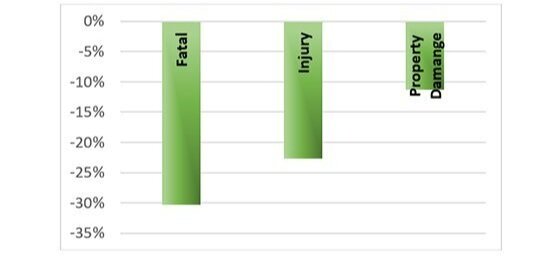Changing Highway Truck Weight Limits Can Be Safer for Everyone
Truck weight limits are a frequent topic of policy debates in the forest industry. All too often, the discussion is devoid of facts and analysis and full of emotional appeals. The industry asserts that moving loaded trucks onto the Interstate Highway System will be safer and more efficient. At the same time, some safety advocates counter that heavy trucks on the highway must pose a danger.
Fortunately, there is data to help us understand what changing truck weights can do for road safety. Section 194 of the Consolidated Appropriations Act of 2010 (Public Law (P.L.) 111-117) directed the Secretary of Transportation to study the impacts of the Maine and Vermont truck pilot programs, which replace federal commercial-vehicle weight regulations with state limits on interstate highways in those states. In Maine, that means allowing trucks up to 100,000 pounds gross vehicle weight on six axles onto the federal highway. In Vermont, the federal highways matched state limits of a maximum gross vehicle weight of 99,000 pounds on six axles.
It has been over a decade since that legislation passed, and we can see that roads have gotten safer. Analyzing all accidents involving medium and heavy weight trucks statewide in Maine, we see that the average number of fatal, injury-causing, and property-damage causing accidents decreased when looking at the years before heavier trucks were allowed on the highway (2005-2009iii) and for the years following (2011-2020iv).
Accidents Involving Medium and Heavy Weight (>10,000 lbs.) Trucks, Statewide (Maine)
Change in Maine Statewide Truck Accidents Following Alignment of State and Federal Weight Limits on Interstate Highways
In 2015, the Maine Motor Transport Association(v) conducted a detailed analysis of how the change in truck weight limits on the federal interstate highway in Maine impacted safety and found that after the truck weight change:
There are fewer fatalities involving commercial motor vehicles on Maine roads;
The Interstate Highway (I-95) is safer;
Secondary roads are safer;
The average total number of crashes involving all commercial trucks has reduced by almost 100 (now, in 2021, by over 150); and
There are fewer crashes involving six-axle trucks.
As the forest industry strives to be safe and efficient, it is essential to understand how policy changes can impact others. Due to changing truck weight laws so that the Interstate Highway System matches state law (long an FRA policy priority), Maine’s experience suggests that getting heavy trucks off secondary roads and onto the highway reduces fatalities, injuries, and accidents involving commercial trucks.
Author/Source: Eric Kingsley | FRA Northeast Region Coordinator
i. US Department of Transportation, Federal Highway Administration. Maine and Vermont Interstate Highway Heavy Truck Pilot Program 6-Month Report. https://ops.fhwa.dot.gov/freight/sw/reports
ii. Database query at Maine Department of Transportation, Maine Public Crash Query Tool, https://mdotapps.maine.gov/MaineCrashPublic/PublicQueryStats
iii. The data set begins in 2005, so data on crashes statewide is unavailable for dates before then using this tool.
iv. It appears that the weight change took effect during 2010, so that year’s data has been excluded from both data sets.




